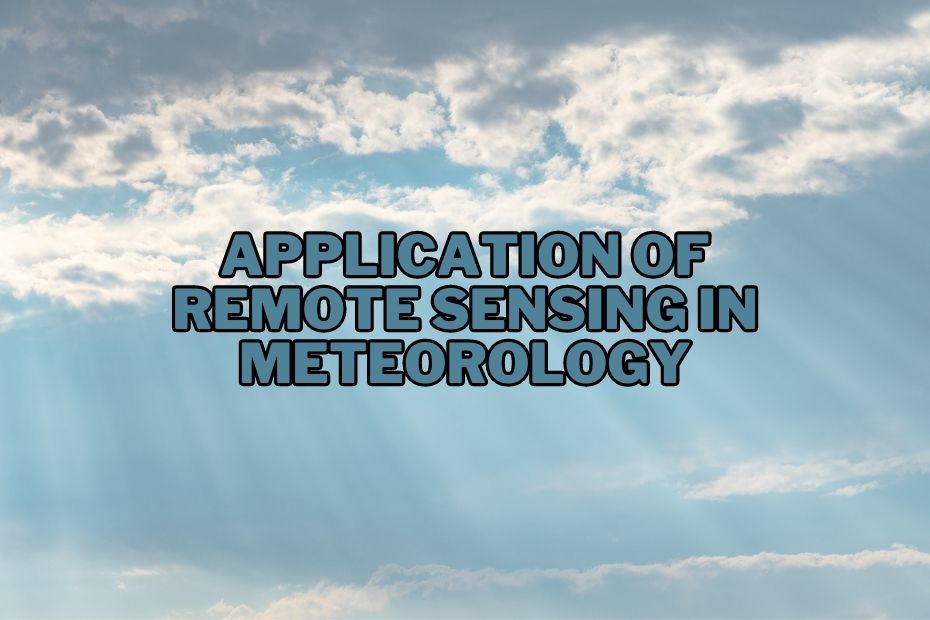By harnessing the power of remote sensing, meteorologists can gather invaluable insights into weather patterns, atmospheric conditions, and climate trends. In this article, we will explore compelling application of remote sensing in meteorology, shedding light on how this technology revolutionizes weather forecasting and analysis.
Remote sensing plays a pivotal role in meteorology by enabling the collection of valuable atmospheric data from a distance. It aids in monitoring weather patterns, tracking storms, and assessing climate changes through satellite imagery and sensors.
Application of Remote Sensing In Meteorology
Remote sensing, often facilitated by satellites orbiting the Earth, enables us to monitor the environment with remarkable precision. In the realm of meteorology, this technology plays a vital role in enhancing our understanding of weather dynamics.
1. Weather Forecasting and Prediction
Remote sensing plays a pivotal role in weather forecasting and prediction. Satellites equipped with specialized sensors monitor various atmospheric parameters such as temperature, humidity, and pressure. This data is then processed to create intricate weather models that offer accurate short-term and long-term forecasts. By analyzing cloud formations, wind patterns, and temperature fluctuations, meteorologists can anticipate weather changes and issue timely alerts to communities and industries, minimizing potential risks.
2. Climate Monitoring and Analysis
The monitoring and analysis of climate are essential to comprehend the Earth’s changing climate patterns. Remote sensing provides an efficient way to track climatic variables, such as greenhouse gas concentrations and sea surface temperatures. These observations aid scientists in identifying trends and anomalies, contributing to a better understanding of global climate change and its potential impacts.
3. Storm Tracking and Analysis
When it comes to understanding and mitigating the impact of storms, remote sensing proves invaluable. Advanced satellites can track the formation and movement of storms, including hurricanes and typhoons, with remarkable precision. By continuously monitoring their growth, trajectory, and intensity, meteorologists can issue accurate warnings and help authorities plan for evacuations and disaster response.
4. Precipitation Estimation
Precipitation estimation is crucial for water resource management, agriculture, and disaster preparedness. Remote sensing technology allows for the measurement of rainfall and snowfall over large areas. By combining data from ground-based sensors and satellites, meteorologists can create accurate precipitation maps, aiding in flood prediction and water supply planning.
5. Atmospheric Composition Analysis
Understanding the composition of the atmosphere is vital for assessing air quality and environmental health. Remote sensing instruments can detect pollutants and trace gases in the atmosphere, providing critical information for atmospheric composition analysis. This data is used to monitor air quality, study the effects of pollution on human health, and support policymaking for sustainable urban development.
6. Ocean and Sea Surface Monitoring
Remote sensing extends beyond land and atmosphere, reaching the vast oceans and seas. Satellites equipped with radar instruments can monitor ocean and sea surface conditions, including sea surface temperatures, currents, and even oil spills. This information aids in tracking marine ecosystems, studying ocean dynamics, and predicting events such as El Niño and La Niña phenomena.
7. Urban Heat Island Analysis
Urban areas often experience higher temperatures compared to surrounding rural regions, a phenomenon known as the urban heat island effect. Remote sensing allows scientists to monitor temperature variations across urban landscapes and analyze heat distribution. This information assists city planners and policymakers in implementing strategies to mitigate the urban heat island effect and improve urban livability.
8. Snow Cover and Glacial Monitoring
The monitoring of snow cover and glaciers is essential for understanding water availability and the impacts of climate change on mountain ecosystems. Remote sensing technologies enable scientists to track changes in snow cover extent, glacier volume, and ice melt rates. This information contributes to assessing water resources, predicting glacial retreat, and planning for potential water scarcity.
9. Monitoring Climate Change
Remote sensing is a cornerstone of monitoring climate change on a global scale. By continuously collecting data on temperature trends, ice sheet dynamics, and vegetation changes, researchers can quantify the impacts of climate change over time. This data is crucial for informing international climate agreements, guiding adaptation strategies, and raising awareness about the urgent need for environmental conservation.
10. Mapping Land-Atmosphere Interactions
Remote sensing facilitates the study of interactions between the land surface and the atmosphere. This includes monitoring soil moisture, vegetation health, and land cover changes. Such data helps improve our understanding of climate feedback mechanisms.
11. Rainfall and Precipitation Estimation
Accurate measurement of rainfall and precipitation is vital for flood prediction and water resource management. Remote sensing instruments, such as radar and radiometers, help meteorologists estimate precipitation levels across different regions, contributing to effective disaster preparedness and response strategies.
Conclusion
In conclusion, the application of remote sensing in meteorology has transformed our ability to understand, predict, and adapt to weather and climate changes. From accurate weather forecasting to comprehensive climate analysis, remote sensing technology continues to play a vital role in shaping the future of meteorology and ensuring the safety and well-being of communities worldwide.
FAQs: Application of Remote Sensing In Meteorology
How does remote sensing improve weather forecasting?
Remote sensing provides real-time data on temperature, cloud cover, and precipitation, enabling meteorologists to make more accurate predictions.
Can remote sensing track extreme weather events?
Yes, remote sensing enhances the detection and tracking of extreme weather events, allowing for early warnings and preparedness.
What role does remote sensing play in tracking storms?
Remote sensing satellites track storm formation, intensity, and trajectory, enabling timely warnings and effective disaster response planning.
Why is monitoring glacial changes important?
Remote sensing allows scientists to monitor glacial retreat, ice melt rates, and snow cover changes, providing insights into water resource availability and the effects of climate change.
